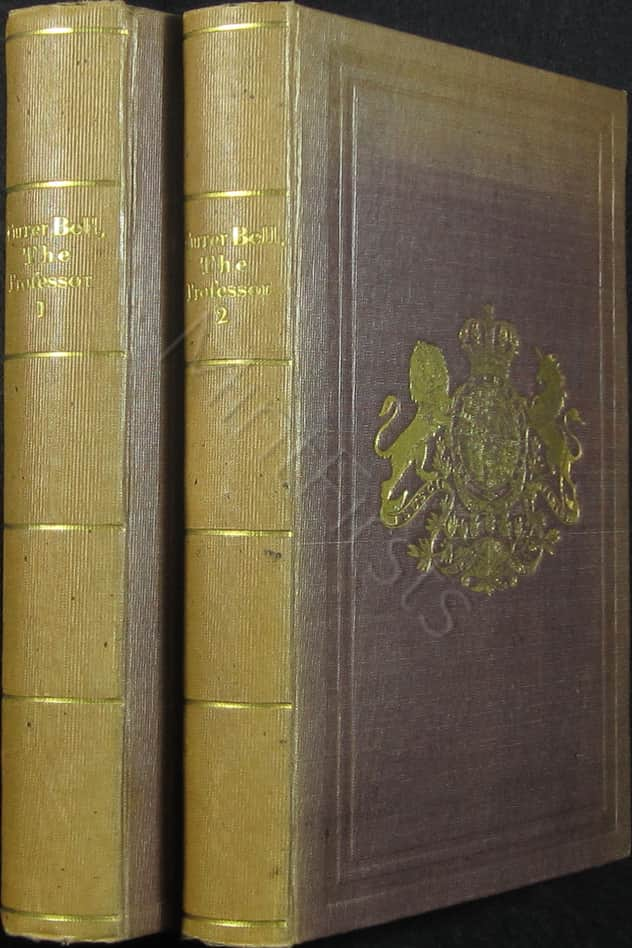Established
2004
Relaunched
2024
Our booksHow we tradeAbout usCredits & thanksYour account
- Home page
- Our books
- How we trade
- About us
- Credits & thanks
- Your account
- Your cart
MENU
The Professor, A Tale.
First edition of Charlotte Brontë's The Professor (King of Hanover's copy)

Currer Bell ⦗Charlotte Brontë, 1816–1855⦘
First edition. In 2 vols. 8vos. Vol. 1: Pp. viii, 294, [2, ads]. Vol. 2: Pp. [iv], 258. Contemporary royal binding of vertically ribbed, grey-mauve cloth with borders stamped in blind, and titled and ruled in gilt to spines. Half titles present; with one leaf of adverts for Mrs Gaskell's Memoirs of Currer Bell to rear of volume one. No adverts or publisher's catalogue to rear of vol. 2. With the author's Preface, written "with a view to [its] publication shortly after the appearance of Shirley" (1849), and a Note by her widower, A[rthur] B[ell] Nicholls, dated September 22nd, 1856 to vol. 1.
First printing of the author's first novel, published posthumously, on 6 June 1857. With all correct first issue points: the final letters in the last words on lines 1 & 2 on p. 21 of vol. 1 are transposed (i.e., foggn / introductioy); periods missing after the headlines on pp. 58 and 221 of vol. 2, while in line 3 on p. 99 of same vol. the letter 'p' is lacking from the word 'place'.
The King of Hanover's [König Georg V (1819–1878)] copy; with his royal coat of Arms, gilt stamped in blind on covers, and bearing the circular library stamp with the motto of the order of Ernst August "SUSCIPERE ET FINIRE" – founded in 1865 in memory of his father, König Ernst August (1771–1851) – to versos of title pages.
The only child and successor to King Ernest Augustus, George V bears the distinction of being the last King of Hanover, his reign ended with the unification of Germany in 1866. During his autocratic 15-year reign, he engaged in frequent disputes with the Hanoverian parliament and sided with Austria in the Austro-Prussian War. With Prussia triumphant, the deposed King fled to Austria, from where he waged an unsuccessful public campaign of restitution to the Hanover throne, which he never renounced. As a legitimate male-line descendant of George III, he remained a member of the British Royal Family, and second in line to the British throne, until the birth of Queen Victoria's first child, Victoria, Princess Royal, in 1840. He is buried in St George's Chapel at Windsor Castle.
Some discolouration to spines and upper strip of vol. 1, which also sustains a couple of brownish spots to its fore-edge, light foxing to prelims. A wonderful set overall. From the library of the Royal House of Hanover at Marienberg.
Originally entitled The Master, a coming of age tale of an orphaned mill clerk who takes up a posting as an instructor at an all-girls' boarding school in the Belgian capital, based on Brontë's brief sojourn in Brussels, where she studied and taught in the early 1840s. Repeatedly turned down by publishers for lacking a plot replete with "fantastical coincidences or unbelievable romance," much of its subject matter was subsequently reworked into her novel Villette (1853), from a female tutor's point of view.
[Symington (1927), p. 116; Sadleir 347; Smith, Brontë, 7.]
edition
first edition
format
hardback
scarcity
scarce
publisher
Smith, Elder & Co.
published in
London
publication year
1857
volumes
2
height × width
19 × 13.5 cm
genre
literary fiction
language
English
binding style
cloth
binding state
contemporary binding
condition
fine
GBP£ 3,400
EUR€ 3,980
USD$ 4,550
ref.9R4 C39